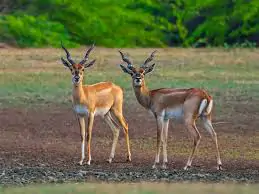Introduction to Point Calimere Bird Sanctuary
Point Calimere Bird Sanctuary, also known as Kodikkarai Wildlife Sanctuary, is located in the state of Tamil Nadu, India. It is one of the most important wetland ecosystems in the country and serves as a critical habitat for a variety of bird species, especially migratory ones. Spanning an area of around 21.47 square kilometers, this sanctuary is strategically situated at the tip of the Palk Bay in Tamil Nadu.
🦢 The Sanctuary’s Ecological Importance
The sanctuary plays an integral role in biodiversity conservation in India. It is particularly famous for being a stopover point for many migratory birds, particularly during the winter months. The sanctuary’s environment, comprising mudflats, mangroves, and salt marshes, creates an ideal habitat for waders, shorebirds, and waterfowl.
Among the notable species found here are Greater Flamingos, Bar-Headed Geese, Little Terns, and Indian Spot-Billed Ducks. The sanctuary is a paradise for bird watchers and a crucial site for ornithological research in the region.
🌿 Flora and Fauna of the Sanctuary
Apart from its diverse avian population, Point Calimere is home to varied flora and fauna, including mangrove plants, crabs, fish, and other species of reptiles. The sanctuary’s coastal ecosystem is vital for preserving the ecological balance of the region, supporting both terrestrial and marine life.
The area is also home to spotted deer, blackbucks, and wild boars, making it a significant location for land-based wildlife observation as well.
🌟 Conservation Efforts and Challenges
Point Calimere faces several conservation challenges, such as illegal poaching, habitat degradation, and the increasing threats posed by climate change. However, government agencies and local organizations continue to work towards protecting the sanctuary’s unique biodiversity. The sanctuary is managed by the Tamil Nadu Forest Department, which is responsible for its conservation efforts.

📌 Why This News is Important
🐦 Point Calimere’s Contribution to Biodiversity Conservation
Point Calimere Bird Sanctuary’s significance lies not only in its role as a habitat for migratory birds but also in its broader contribution to biodiversity conservation in India. As the sanctuary attracts numerous bird species, especially migratory ones from various parts of the world, it highlights the country’s ecological diversity and the need for preserving such habitats. In the context of competitive exams, understanding the importance of wildlife conservation areas like Point Calimere is crucial, as it helps in shaping knowledge about India’s efforts in environmental protection.
🌏 Focus on Wetland Ecosystems in Current Affairs
In recent years, there has been an increasing focus on the preservation of wetland ecosystems across India. These areas are being recognized for their role in water purification, carbon sequestration, and flood control, making it a priority for the government to implement policies for their protection. Students preparing for exams like UPSC, SSC, and state civil services must understand the importance of wetlands and their impact on India’s ecological health.
📚 Key for Competitive Exams
The Point Calimere Bird Sanctuary is relevant for students preparing for competitive exams like UPSC, SSC, and other exams with environmental science, geography, and current affairs sections. The sanctuary’s role in maintaining biodiversity, conservation practices, and its location are all key areas that might appear in the environmental studies and general knowledge sections of the exams.
🕰️ Historical Context
🌱 The Role of Wetlands in India’s Ecosystem
India, known for its rich and diverse ecosystems, has several wetland ecosystems across the country, including those in the Sundarbans, Kolleru Lake, and Keoladeo National Park. Wetlands like Point Calimere are integral for maintaining the health of both terrestrial and marine life. Historically, wetlands in India have been used for fishing, agriculture, and as habitats for wildlife, but over time, they have faced threats from urbanization and industrialization.
🦉 Conservation Movements and Protected Areas in India
India has made significant strides in wildlife conservation, particularly through initiatives like the Project Tiger and National Wildlife Protection Act, aimed at safeguarding endangered species and preserving natural habitats. The establishment of wildlife sanctuaries and national parks, such as Point Calimere, is part of a broader effort to protect India’s flora and fauna, ensuring their survival for future generations.
✅ Key Takeaways from ‘Point Calimere Bird Sanctuary’
| S.No. | Key Takeaway |
|---|---|
| 1 | Point Calimere Bird Sanctuary is located in Tamil Nadu, India. |
| 2 | The sanctuary is an important stopover for migratory birds, especially during the winter months. |
| 3 | The sanctuary supports diverse ecosystems, including mangroves, salt marshes, and mudflats. |
| 4 | Conservation efforts in the sanctuary face challenges like illegal poaching and habitat degradation. |
| 5 | The sanctuary is home to a variety of species, including Greater Flamingos, Bar-Headed Geese, and Blackbucks. |
Frequently Asked Questions (FAQs)
1. Where is Point Calimere Bird Sanctuary located?
Point Calimere Bird Sanctuary is located in the state of Tamil Nadu, India, at the southern tip of the Palk Bay.
2. What is the significance of Point Calimere Bird Sanctuary?
It is a critical habitat for migratory birds, especially during the winter months. The sanctuary is famous for supporting diverse species such as Greater Flamingos, Bar-Headed Geese, and Little Terns.
3. What types of species can be found at Point Calimere?
Apart from migratory birds, the sanctuary is home to species like blackbucks, spotted deer, and various types of flora like mangroves and salt marshes.
4. Why is Point Calimere important for migratory birds?
The sanctuary provides a suitable environment for birds to rest and feed during their long migration, making it one of the most significant stopovers in the region.
5. What are the main conservation challenges faced by the sanctuary?
The sanctuary faces challenges like illegal poaching, human encroachment, and habitat degradation, which threaten its delicate ecosystem.
Some Important Current Affairs Links


















